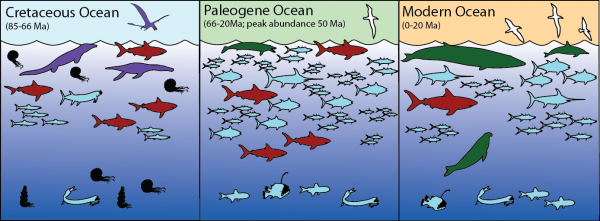With Ph.D student, Elizabeth Sibert, I have been using the fossil record of fish teeth in the open ocean to reconstruct fish populations through recent geologic history.

A recent result of this work is the finding (in Sibert and Norris. 2015), that there has been a dramatic change in the relative abundance of fish and sharks in the open ocean over the past 85 million years. In the Cretaceous oceans (>66 Ma), the production of shark denticles (mineralized scales) was about equal to that of fish teeth. However, after the Cretaceous-Paleogene mass extinction (66 Ma), fish production doubled over that of sharks, and later doubled again, while sharks remained ‘stuck’ with Cretaceous-rates of abundance. New, unpublished work further shows that about 20 million years ago, shark production dropped dramatically relative to fish—a situation of low shark abundance that persists to the present day.
We have dubbed these changes in shark and fish abundances, the “Cretaceous Ocean”, “Paleogene Ocean” and “Neogene Ocean” (see figure above) that each reflects different basic roles for sharks and fish in open ocean ecosystems. We speculate that in the Cretaceous, fish and sharks competed extensively against now extinct groups of predators such as the ammonites. The removal of ammonites by mass extinction ‘released’ fish from predation and allowed them to explode in abundance in the warm ‘greenhouse’ world of the Paleogene. Later, in the Neogene, the evolutionary diversification of marine mammals, seabirds and large pelagic fish effectively competed with sharks, driving shark abundance down in the pelagic ocean.
Open-ocean sharks in decline for the past 20 million years
